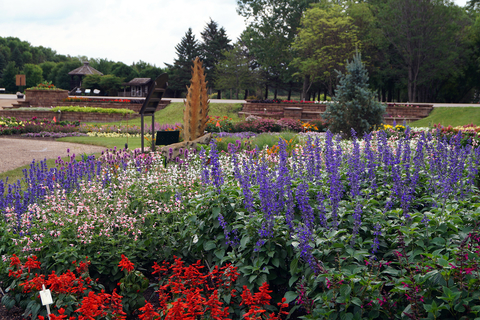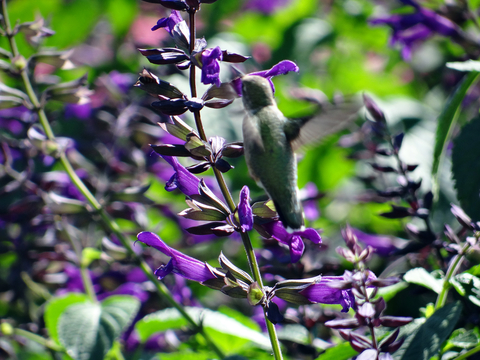Quick facts
- Salvia are very low maintenance, easy to grow plants that perform well in garden beds but not containers.
- Salvia need full sun and well-drained soil.
- They come in a wide range of sizes and colors.
- Salvia are very light feeders with little to no disease or pest issues.
- Common flower colors: shades of blue, purple, pink, red, white and yellow.
Salvia is a large genus of plants that are widespread around the globe. They have been used for their herbal and medicinal properties for thousands of years. Garden sage is a common product of salvia that people use as a seasoning.
Salvia is in the mint family and like other mints, their leaves are very aromatic. They are perennials in their native habitat but are grown as annuals in our climate.
There are four main species of ornamental annual salvias: Salvia coccinea, farinacea, splendens and patens. In general, they can all be treated the same and require the same care.
Ornamental salvias are known for floral spikes that are densely packed with colorful flowers. There is a wide range of flower colors that are not only attractive to humans, but to pollinators too. A garden containing salvia will often have many bees, butterflies and hummingbirds visiting the flowers for nectar and pollen.
Salvia cultivars have a wide range of sizes, from 1 to 5 feet tall.
Good performers
Annual salvias are evaluated as part of the U of M flower trials and research. Located at the West Central Research and Outreach Center in Morris, MN, the Horticulture Display Garden serves as an All-America Selections (AAS) Display Garden and Trail Grounds and provides the public an opportunity to view the newest superior performers.
The following annual salvia cultivars were rated good to excellent in our recent trials:
- White Flame
- Purple & Bloom
- Interspecific Big Blue
- Victoria Blue
- Mystic Spires Improved
- Rockin’® series
- Sallyfun™ series
Growing outdoors
Salvias should not be grown in containers due to their large size but they thrive in garden beds. They can be planted outdoors once soil temperatures are above 55 degrees F.
Plants should be spaced 1 to 3 feet apart depending on the cultivar.
Guidelines for choosing a site:
- Must have full sun for 8+ hours a day.
- Soil must be well-drained as salvias prefer it on the drier side.
- To improve drainage, compost or sand can be incorporated into heavy soils.
- Soil pH of 6-7.
Add general purpose fertilizer with equal amounts of nitrogen, phosphorus and potassium to the soil at the time of planting. Incorporate fertilizer by watering or a natural rain event.
Plants do not need to be fertilized throughout the summer but a monthly fertilizing at half the recommended rate can increase the number of blooms.
Salvias require semi-regular watering but are very drought tolerant and will do better in drier soil than overly moist soil. Lightly water when the top 2 inches of soil is dry.
Pests and diseases are usually not an issue with this plant.
Other tips for abundant blooms and healthy plants:
- Clip off old flower spikes to promote the growth of new flowers.
- If plants are looking overgrown or not abundantly flowering, they can be cut back in mid-summer and will regrow resulting in fresh foliage and flowers.
- Keep the soil surface free of debris to prevent the growth of disease.
Starting seeds indoors
Salvia seeds can be started indoors about 9 weeks prior to the anticipated outdoor planting date. All species can be started using the same techniques. Use a growing medium specifically designed for germinating seeds. Follow these guidelines for successful seed propagation:
- Lightly place seeds on growing medium and cover with vermiculite.
- Keep moist by using a plastic cover over the seeding tray.
- Seeds will germinate in 7 to 14 days at 70-75°F
- After germination, grow plants at 60-65°F during both the day and night.
- Make sure to allow media to slightly dry out between waterings to prevent seedlings from dampening off.
Salvia pollinators
Salvias are pollinator magnets and will attract many different species of bees, butterflies and even hummingbirds. If using salvias to create a pollinator garden, make sure to also provide other resources for the pollinators.
Follow these tips for a very active garden:
- A water source should be located nearby such as a birdbath so that the pollinators have a place to land and drink.
- It is also important to provide some habitat.
- You can buy premade products such as “bee boxes” to provide a home for pollinators.
- A small pile of brush or old wood in or near the garden for pollinators to make a home in works just as well.
- Be sure to leave some bare soil in the garden for ground-nesting pollinators to burrow into.
Reviewed in 2021






